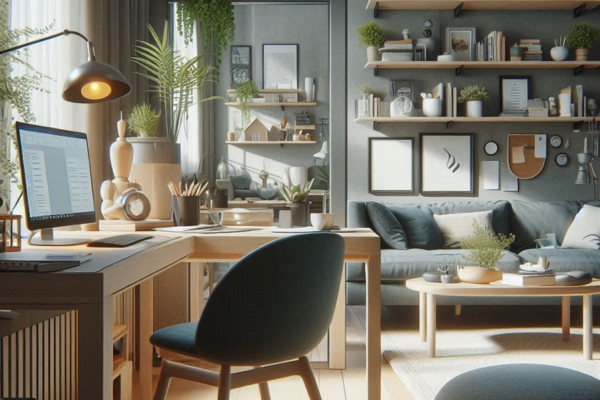In small apartments, finding room for a home office can be a real challenge. When every square meter counts, the hallway—a space often overlooked—might just be the hidden gem you’ve been missing. But can a hallway really function as a productive workspace? The answer is yes—if it’s designed thoughtfully.
In this article, we’ll explore how to set up a functional, stylish, and efficient home office in your hallway, and answer the big question: does it really work?
Why the Hallway?
Hallways are usually transitional spaces. We walk through them, store coats in them, but rarely consider them functional zones. However, with strategic planning, even narrow hallways can become productive micro-offices.
Advantages:
- Utilizes otherwise unused space
- Keeps your main living areas clutter-free
- Can be surprisingly quiet and distraction-free
- Offers creative design possibilities
1. Assess the Space You Have
Start by measuring your hallway:
- Width: You’ll need at least 75–80 cm (30–32 in) of width to place a shallow desk and allow passage.
- Length: A wall span of just 100–120 cm (40–48 in) is often enough for a compact workstation.
- Lighting: Note if there’s access to natural light or if you’ll need to install fixtures.
Also, consider foot traffic. If the hallway is busy or narrow, opt for a foldable or wall-mounted solution.
2. Choose the Right Desk Type
Space is tight, so go slim and efficient.
Best hallway-friendly desk options:
- Wall-mounted desks: Fold-down models save space and disappear when not in use.
- Console tables: Shallow but functional—perfect for laptops and light work.
- Narrow writing desks: With widths as slim as 30–40 cm (12–16 in).
- Floating shelves with brackets: Minimalist and effective for quick tasks.
Look for built-in cable holes or clamp-on power strips for tech management.
3. Use Vertical Space for Storage
Hallways don’t offer room for deep drawers, so think up—not out.
Ideas:
- Floating shelves: For books, boxes, or decorative storage.
- Wall grids or pegboards: Great for supplies and organizing without bulk.
- File holders and magazine racks: Mounted to the wall for paperwork.
- Slim vertical cabinets: If depth allows.
Make sure shelves are at a height that doesn’t obstruct your head or feel cramped.
4. Opt for a Compact, Comfortable Chair
While big office chairs are tempting, they won’t work in narrow spaces.
Ideal options:
- Stools: Tuck neatly under a desk when not in use.
- Armless dining chairs: Simple and compact.
- Folding chairs: Can hang on a wall hook when not needed.
- Ergonomic kneeling chairs: If you’re working short hours.
Ensure there’s enough clearance for your legs and knees—even with shallow desks.
5. Master the Lighting
Hallways often lack good lighting. Good task lighting is essential for productivity and comfort.
Best solutions:
- Clip-on desk lamps: Attach to desks or shelves.
- Wall sconces: Plug-in or battery-powered for renters.
- LED light strips: Mounted under shelves for even illumination.
- Motion-sensor lights: Great if your hallway doesn’t have easy access to outlets.
Choose warm, soft lighting for comfort, but ensure it’s bright enough for focused tasks.
6. Add Visual Separation (If Needed)
If your hallway is part of an open-plan layout, use design cues to separate your workspace.
Try:
- A small rug or mat: Visually anchors the desk zone.
- Paint or wallpaper: Create an accent wall behind the desk.
- Curtain or fabric panel: Hang from the ceiling to provide temporary privacy.
- Framed art: Makes the nook feel intentional, not improvised.
Even in a narrow corridor, visual separation can boost your mental focus.
7. Keep It Tidy and Clutter-Free
Because the hallway is a shared, high-traffic zone, keeping it organized is crucial.
Tips:
- Use cable clips and cord covers to manage wires.
- Store supplies in labelled boxes or drawers.
- Tuck away tools at the end of the workday to reset the space.
- Add a decorative basket under the desk for bags or extras.
A clean hallway workspace keeps your entire apartment feeling orderly.
8. Decorate with Style, Not Stuff
Hallways are narrow, so go minimalist.
Decoration ideas:
- A small plant on a shelf or desk for life and color
- Framed art prints for personality
- A corkboard or dry-erase board for notes
- Matching containers and organizers for a polished look
Stick to a limited palette to keep the visual clutter low.
9. Address Noise and Distractions
Hallways aren’t always quiet—especially if near the front door or a shared area.
Solutions:
- Use noise-canceling headphones
- Add a rug to soften footstep echoes
- Hang fabric wall art or tapestries to absorb sound
- If needed, use a privacy screen when in meetings
For focused work, a little soundproofing goes a long way.
10. Evaluate Your Work Style
A hallway setup works best for:
- Remote workers with light tech needs
- Part-time work-from-home professionals
- Students or freelancers who need a flexible spot
- People who love minimalism and order
If you need multiple monitors, heavy hardware, or intense privacy—this may not be the best solution. But for many, it works surprisingly well.
Does It Really Work?
Yes, a hallway home office works when:
- The setup is intentional and compact
- Tools are chosen for both form and function
- Lighting and storage are thoughtfully integrated
It won’t replace a full office, but it will give you a dedicated space to focus, create, and stay organized—even in a very small home.
If you’ve been struggling to fit a desk into your small apartment, don’t overlook your hallway. With the right desk, good lighting, clever storage, and thoughtful design, your hallway can become a surprisingly effective home office.
It’s about working smarter with the space you already have—and sometimes, that’s just a few feet of wall in a quiet corridor.

